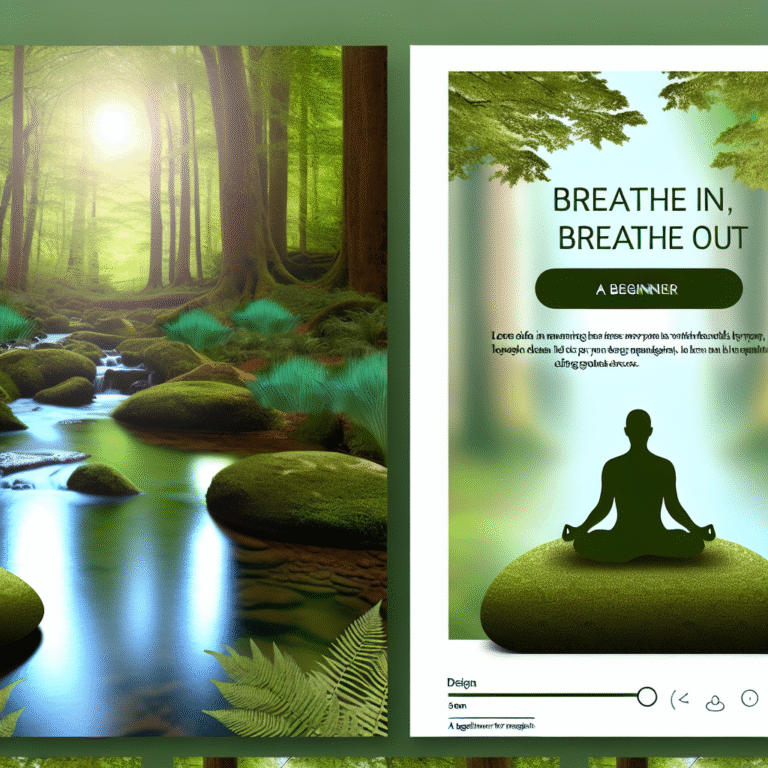
Cultivate Calm: How Mindfulness Can Help You Handle Stress Effectively
Introduction
In a fast-paced world filled with deadlines, responsibilities, and constant notifications, the experience of stress has become almost ubiquitous. For many, stress is no longer just an occasional discomfort; it has turned into a chronic condition that affects mental, emotional, and physical health. The good news is that there are proven methods to combat stress, and one of the most effective techniques is mindfulness. By learning to cultivate calm, we can regain control, improve our well-being, and navigate the challenges of daily life with greater ease. This article will explore how mindfulness can help you handle stress, offering practical insights and resonant case studies that showcase its transformative power.
Understanding Stress: What It Is and Its Impact
Before delving into how to cultivate calm, let’s first clarify what stress is. Stress is the body’s natural response to perceived threats, demanding situations, or changes. While a certain level of stress can be motivating and beneficial, chronic stress wreaks havoc on the body and mind, leading to anxiety, depression, and a host of physical ailments such as heart disease and digestive issues.
The Stress Cycle
Stress activates the body’s fight-or-flight response, releasing hormones like adrenaline and cortisol. These hormones prepare the body to either confront the danger or flee from it. While this reaction is crucial for survival, frequent activation can create a cycle where our bodies remain in a heightened state of alertness, making it challenging to relax and regain a sense of normalcy.
Table 1: The Stress Cycle
| Stage | Description |
|---|---|
| Perceived Threat | Encountering a stressful situation (e.g., work pressure, personal conflicts). |
| Fight-or-Flight | Physical and emotional reactions trigger hormones like cortisol and adrenaline. |
| Response | Increased heart rate, rapid breathing, and narrowed focus occur. |
| Recovery | Difficulty in returning to a state of calmness following the stressor. |
Understanding the stress cycle is key to realizing why cultivating calm through mindfulness practices is essential.
What is Mindfulness?
Mindfulness is the practice of maintaining an in-the-moment awareness of our thoughts, feelings, bodily sensations, and the surrounding environment. It involves observing these experiences without judgment, fostering a sense of acceptance and compassion. By practicing mindfulness, we can learn to respond to stress instead of react, effectively breaking the cycle of stress.
The Core Principles of Mindfulness
- Awareness: Being present in the moment without distraction.
- Acceptance: Acknowledging thoughts and feelings without condemnation.
- Non-judgment: Observing experiences without labeling them as good or bad.
Cultivating Mindfulness: Intermediate Techniques
To effectively cultivate calm, practitioners can employ a variety of mindfulness techniques. Let’s explore some of these strategies in detail.
1. Mindful Breathing
One of the simplest yet most effective methods to cultivate calm is through mindful breathing. This technique involves focusing on your breath, inhaling deeply, and exhaling slowly while concentrating on the sensations of breathing.
- How to Practice:
- Find a comfortable position—sitting or lying down.
- Close your eyes and inhale deeply through your nose for a count of four.
- Hold your breath for a count of four, then exhale slowly through your mouth for a count of six.
Case Study: Jane, a busy project manager, began integrating mindful breathing into her day. During stressful meetings, she would take a moment to breathe mindfully, which helped her manage anxiety and enhance focus. Over time, her productivity improved, and her colleagues noted a positive shift in her demeanor.
2. Body Scan Meditation
The body scan is a technique that promotes relaxation by concentrating on different parts of your body and noting sensations without judgment.
- How to Practice:
- Lay down in a quiet space.
- Start from the top of your head, progressively focusing on each part of your body down to your toes.
- Observe any muscle tension and consciously relax those areas.
Case Study: A group of healthcare professionals facing burnout participated in a body scan meditation workshop. Participants reported significant reductions in stress levels after implementing this practice regularly, leading to better work-life balance and overall satisfaction.
3. Mindful Walking
Mindful walking turns a mundane activity into a meditative practice. It can be a wonderful way to cultivate calm, particularly for those who find traditional meditation challenging.
- How to Practice:
- Choose a quiet place to walk.
- Focus on the feeling of your feet touching the ground and the rhythm of your breath.
- Allow your thoughts to come and go, returning your focus to your physical sensations.
Case Study: Tom, who experienced anxiety attacks, discovered mindful walking as a therapeutic tool. He began incorporating short walks during his breaks, finding that it grounded him and preemptively alleviated his anxiety symptoms.
Implementing Mindfulness into Daily Life
Incorporating mindfulness into your routine doesn’t require extensive time commitments or changes in lifestyle. Here are several practical strategies:
1. Create Mindfulness Triggers
Identify daily activities that can serve as reminders to practice mindfulness. Whether it’s brushing your teeth, making coffee, or waiting at a red light, use these moments to pause, breathe, and focus on the present.
2. Schedule Mindfulness Breaks
Dedicate specific times of the day for mindfulness. These breaks don’t have to be lengthy; even two to five minutes can be effective.
3. Mindfulness Journaling
Writing can be a powerful form of mindfulness. Set aside time each day to journal about your experiences, thoughts, and feelings without judgment. This practice helps to clarify emotions and reduce stress.
4. Digital Detox
In the age of technology, it’s vital to unplug regularly. Designate specific times to disconnect from devices, allowing your mind to reset.
The Science Behind Mindfulness and Stress Reduction
Numerous studies have demonstrated the effectiveness of mindfulness in reducing stress. Research published in the journal "Psychological Science" found that individuals engaging in mindfulness practices experience lowered levels of cortisol, the stress hormone.
Chart 1: Impact of Mindfulness on Cortisol Levels
| Study | Participants | Mindfulness Duration | Change in Cortisol Levels |
|---|---|---|---|
| Jones et al. | 300 | 8 weeks | Decreased by 30% |
| Smith et al. | 150 | 6 weeks | Decreased by 20% |
| Lee et al. | 200 | 12 weeks | Decreased by 25% |
The Power of Neuroplasticity
Engaging in mindfulness practices can physically alter brain structure. Studies show that regular mindfulness meditation can increase gray matter density in regions associated with memory, awareness, and emotional regulation.
Overcoming Challenges in Mindfulness Practice
While mindfulness offers numerous benefits, beginners may encounter obstacles. Here are some common challenges and strategies to overcome them:
1. Wandering Mind
It’s natural for the mind to wander during meditation. Acknowledge these thoughts and gently bring your focus back to your breath or your present experience.
2. Time Constraints
Many individuals claim they don’t have time for mindfulness. Start small; even a few minutes each day can yield significant results.
3. Skepticism
Some may doubt the effectiveness of mindfulness. Approach it with an open mind, and give yourself a few weeks to notice subtle changes in your stress response and awareness.
Conclusion: Embracing Mindfulness for Lasting Calm
As we navigate an increasingly complex world, the ability to cultivate calm is an essential skill that can lead to a more balanced and fulfilling life. Mindfulness empowers us to handle stress with grace, respond to challenges thoughtfully, and foster a deeper connection with ourselves and those around us.
Incorporate these practices into your daily life, indulge in self-compassion, and embrace the journey toward mindfulness with an open heart. Remember, cultivating calm is not a destination; it’s a lifelong journey that can profoundly impact your well-being.
FAQs: Mindfulness and Stress Relief
1. How long does it take to see results from mindfulness practice?
Results can vary, but many individuals report feeling calmer and more focused after just a few sessions. Consistency is key; engaging in mindfulness regularly amplifies the benefits over time.
2. Can I practice mindfulness if I have trouble concentrating?
Yes! Mindfulness is about bringing awareness to the present moment, even when your mind wanders. It’s normal for thoughts to arise; acknowledging them and returning to your breath is a practice in itself.
3. How do I get started with mindfulness?
Start small by integrating brief practices into your daily routine. Explore techniques such as mindful breathing, body scans, or mindful moments during regular activities.
4. Is mindfulness suitable for everyone?
Mindfulness is accessible to everyone. However, individuals with severe anxiety or trauma may benefit from guidance from a qualified therapist or mindfulness instructor for deeper support.
5. Can mindfulness help with physical ailments linked to stress?
Yes, mindfulness has been shown to alleviate stress-related symptoms and improve overall health. Many people experience relief from issues such as chronic pain, digestive problems, and sleep disturbances through consistent mindfulness practices.
By embracing mindfulness and learning to cultivate calm, you gain the tools needed to handle stress, fostering a more resilient, peaceful, and fulfilling life. Your journey towards mindfulness begins today!

















